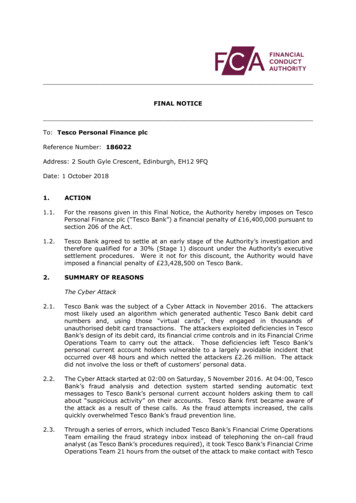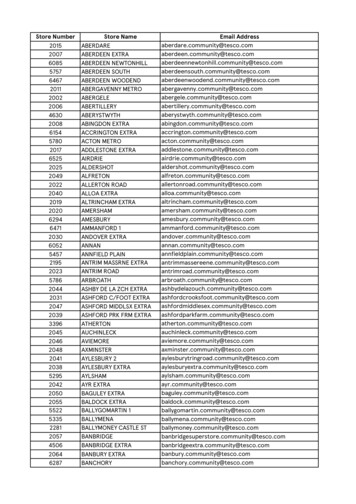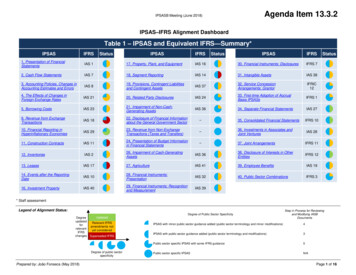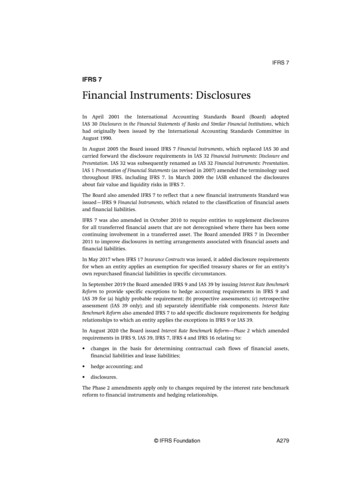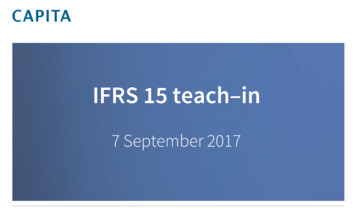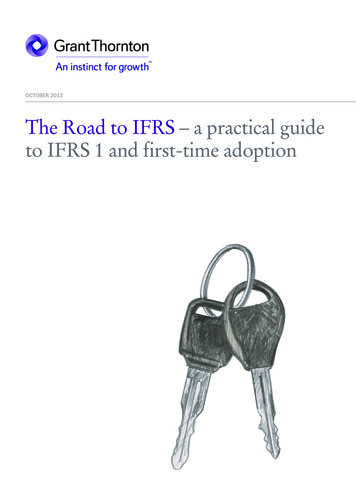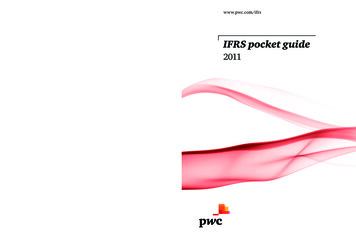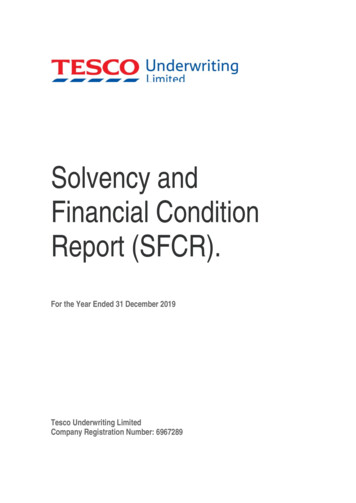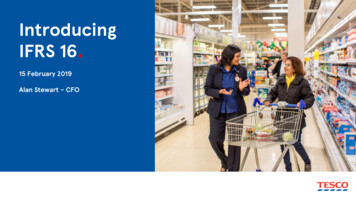
Transcription
IntroducingIFRS 16.15 February 2019Alan Stewart – CFO
Agenda. Introduction Key principles of IFRS 16 Impact on reporting of our financial statements What happens next? Q&A2
Key messages No impact on:– Our economics– How we run the business– Cash Significant impact on reporting of our financial statements:– Leases brought on balance sheet, including extensions (where ‘reasonably certain’) and contingentcommitments– Shape of income statement changes significantly:- Operating profit and margin go up- PBT and EPS go down, due to relative immaturity of lease portfolio Applies to all annual reporting periods beginning on or after 1 January 2019– 2018/19 Prelims will be reported on pre-IFRS 16 basis– First Tesco results published on IFRS 16 basis: 2019/20 Interims (2 October 2019) No bearing on our plans or financial ambitions3
Our approach Two options available for IFRS 16 adoption:– Fully retrospective and modified retrospective Elected to use a fully retrospective approach– As if IFRS 16 had always applied– Most comprehensive and representative view– Comparative year (2018/19) accounts restated Comprehensive and detailed process– Over 9,000 lease contracts individually reviewed and assessed– c.360,000 data points, including commercial terms and historic inputs dating back to lease inception– Two and a half year programme from launch to implementation Balance sheet transition occurs as at 24 February 2018– Focus today on 1H 2018/19 - will form prior period comparatives for October 2019 Interims4
IFRS 16 key principles - Balance sheet Aligns presentation of leased assets more closely to owned assetsBrings both an asset and liability on balance sheet– Lease liability equal to present value of future payments– At inception right of use asset equals lease liability1Over the lease term, the asset and liability differ in value– Right of use asset depreciates evenly– Lease liability decreases by cash rental payments, net ofinterest charged (which reduces over time)– Assets subject to annual impairment testing– Asset and liability also revalued following:– Non-predetermined changes in rent – e.g. RPI-linked rentaluplifts or renegotiation– A reassessment of lease termExample 1: 20 year lease with fixed annual rentalsAsset depreciates evenly over life mTimeLease liabilityRPI inflation recognised as incurredin both asset and liability5Can result in greaterdifference between leaseliability and RoU asset mTimeThe right of use asset is also adjusted for prepayments, legal fees, dilapidations and incentives already receivedExample assumes 3% RPI inflation per annumRight of use assetExample 2: 20 year lease with RPI-linked2 rental upliftsLease liability1.2.Liability decreases bycash rental paymentsnet of interest chargeRight of use asset
IFRS 16 key principles - Income statement Straight-line operating lease rental expense replaced by:– depreciation on right of use asset, straight-lined over lease term– interest charge on lease liability which reduces over lease term Over the life of any lease, the total charge to the income statementis the same as total cash rent paid both pre- and post-IFRS 16 Operating profit and margin always increases as the rental charge isremoved and only partly offset by depreciation 1.However, the impact on PBT and EPS depends on lease maturity:– IFRS 16 is dilutive to EPS at the beginning of a lease and accretiveto EPS at the end of a lease, as interest charged is higher in theearlier years and reduces over time– This effect is more marked if rent increases during the leasee.g. due to RPI-linked rental upliftsExample assumes 3% RPI inflation per annum6Example 1: 20 year lease with fixed annual rentalsEPS dilutive at beginning of lease and accretive at end of lease mInterestTimeDepreciationCash rentalInterest & depnExample 2: 20 year lease with RPI-linked1 rental upliftsWith inflation-linked rent, the cross-over pointis later and accretion is more marked towardsthe end of the lease mInterestTimeDepreciationCash rentalInterest depn
Understanding our lease portfolio Relatively immature:– Around one-third expired– Average total lease length of 26 years 67% of liabilities relate to standalone leases, 33% to leases with JVs 77% of liabilities subject to RPI-linked rental upliftsLease liability m1400120010008006004002000 12345678910111213141516171819202122Years to maturityStandalone stores & other assetsTesco Property Finance JVs7Other JVs2324252627282930
Calculating our IFRS 16 lease liability The lease liability is greater than currently disclosed minimum lease commitments due to:1.1 Inclusion of contingent lease commitments2 Inclusion of extension or post-break periods, where reasonably certain2.3 Application of lease-specific discount rates3.8
1. Inclusion of contingent lease commitmentsExtract shown: Note 21 of the 2018/19 Interim Results statement9
2.2 Inclusion of extension or post-break periods, wherereasonably certain Currently, disclosed lease commitments are based on rent due during the non-cancellable period ofleases – i.e. the minimum amount required to be paidThe IFRS 16 lease liability includes all amounts ‘reasonably certain’ to be paid under any given leaseAs such, in addition to minimum commitments it also includes:– Periods after break clauses if we are reasonably certain we will not break– Extension periods if we are reasonably certain we will extendPOST-IFRS 16 LEASE LIABILITYPRE-IFRS 16 LEASE COMMITMENTSNon-cancellable period (up tobreak point)Periods after break if ‘reasonablycertain’ not to break10Extension periods if ‘reasonablycertain’ to extend
3.3 Application of lease-specific discount rates Discount rate for each lease dependent on:– lease start date– lease term– currency1Euro countryspecific risk Based on rate implicit in lease if can be determined(e.g. where Tesco is involved in the related property JV) Otherwise based on incremental borrowing rate– as at the time we entered into the lease– calculated using multiple data inputsGov. bondyieldsUniquediscountrate foreach leaseGroup creditriskWeighted average discount rate across all leases is 5.8% at Feb 181.Organisation for Economic Co-operation and Development11GlobalratingsagenciesEntity creditrisk
Our lease liability – as at 25 August 2018PRE-IFRS 16POST-IFRS 16 1.0bn 10.6bn1 1.0bn 1.4bn 7.2bnOperating leasecommitments(discounted)Include contingentcommitmentsInclude extension andpost-break periods wherereasonably certainApplication of leasespecific discount ratesAs disclosed withinNote 21 in Interimsstatement1.12Total current and non-current lease liabilities of (10,687)m recorded on Balance Sheet as at 25 August 2018 includes (125)m finance lease liabilities previously included in ‘Borrowings’'New' IFRS 16lease liability(discounted)
Balance sheet – as at 25 August 2018 14.4bnLease liabilitybrought onbalance sheetRight of useasset broughton balancesheet 7.8bn1 right of use asset netof impairment 9.0bn 0.2bnPrimarilyreallocation ofimpairmentfrom PP&E toright of useasset 0.9bn one-off adjustment toworking capital1.Recognise 'new'lease liabilityWe have paidmore tax todate than wewould havedone underIFRS 16 0.7bn (10.6)bnAug 18 Net assets(reported) 13.0bn (1.2)bnRent prepayments andaccruals no longer inworking capital 0.2bn 0.3bnOnerous lease provisions‘replaced’ by impairment onthe assetDerecognise IAS 17working capitalbalancesDerecognise onerouslease provisionsRecogniseright of use asset13ImpairmentThe right of use asset of 7,878m recorded on Balance Sheet as at 25 August 2018 includes 109m assets held under finance lease previously included in ‘PP&E’PP&E impairmentreallocation & otherDeferred taxAug 18 Net assets(restated)
Income statement – for 26 weeks to 25 August 2018 Rental charge replaced by depreciation on right of use asset and interest on lease liabilityIFRS 16 impacts (non-cash)PreIFRS 161 her operating costs(29,584)Operating lease rentals(538)Depreciation(679)Operating profit933JVs and associates20Finance incomeExclude:rentPostIFRS 16131,7346522(16)2(340)522(29,578)(1,019)(340)No changePrincipally relates to gain on disposal of leasesOperating lease rentals removedStraight-line depreciation charge added61,121Operating profit rises(2)18Principally impact on Gain Land associate729Interest on finance sub-leased property includedFinance costs(293)(289)(582)High interest charge, reflecting lease immaturityProfit before tax667566Profit before tax reduces1.2.522(340)Before exceptional items and amortisation of acquired intangiblesRelates to leases not brought on balance sheet by IFRS 16 e.g. short-term leases and leases on low value assets(287)414
Retail cash flow – for 26 weeks to 25 August 2018 Cash flows reclassified between operating and financing activities No change to net cash flowPreIFRS 16Reclassify rentpayment Retail operating cash flow1,123566Net interest and tax(274)(7) mRepayments of obligations under leases as ‘interest’& ‘capitalrepayments’PostIFRS 161,689Operating lease rental removed(286)(560)Interest element of lease payments added(280)(287)Capital element of lease payments addedRetail free cash flow(397)566(566)(397)No change. Definition updated to includerepayments of obligations under leasesNet increase / (decrease) in cash(848)566(566)(848)No change to net cashNote: Select lines of cash flow shown15
Impact on KPIs Retail free cash flow definition amended to include cash rental paymentsChangePostIFRS 16Operating margin12.94%0.59%3.53%Rent removed and only part replaced by depreciationDiluted EPS26.36p(0.91)p5.45pDue to combination of depreciation and interest being higher than therent they replace, driven by relative immaturity of lease portfolioNet debt (3.1)bn (10.5)bn (13.7)bnAddition of ‘new’ lease liabilityTotal indebtedness (12.5)bn (3.3)bn (15.8)bnDue to lease extension and contingent commitments being includedand lease specific discount rates being appliedRetail operating cash flow 1,123m 566m 1,689mRent removedRetail free cash flow 397m- 397mCash flowPreIFRS 16IncomestatementAll current KPIs maintainedBalancesheet 1.2.No change. Free cash flow measure redefined to include repaymentsof obligations under leases16Before exceptional items and amortisation of acquired intangiblesExcludes exceptional items, amortisation of acquired intangibles, net pension finance costs and fair value remeasurements of financial instruments
Impact on debt metrics Metrics redefined post-IFRS 16:– Total indebtedness ratio Net debt defined pension deficit (net of tax) / EBITDAR– Fixed charge cover EBITDAR / (Net finance costs1 cash rent)Fixed charge cover3Total indebtedness 7x2.5x2.4x2.3x2.2xFY 17/18FY 17/181H 18/19Total indebtedness ratioFixed charge coverTotal indebtedness ratio post-IFRS 161.2.3.2.9x2.9x1H 18/19Fixed charge cover post-IFRS 1617IFRS 16 Definition: Net finance costs (before exceptional charges, net pension finance costs, fair value re-measurements) and adjusted to remove IFRS 16 interest expensePre-IFRS 16 Definition: Net Debt defined pension deficit (net of tax) discounted operating lease commitments / EBITDARPre-IFRS 16 Definition: EBITDAR / (Net finance costs (before exceptional charges, net pension finance costs and fair value re-measurements) Retail operating lease expense)
What happens next?Today Sharing 1H 18/19 income statement and cash flow on IFRS 16 basis Sharing opening (Feb 18) and 1H (Aug 18) balance sheet on IFRS 16 basis18/19 Prelims (10 April 2019) Results continue to be reported on pre-IFRS 16 basis Headline summary of IFRS 16 impact on FY18/19 financials to be providedPost Prelims Full FY 18/19 financial statements published on IFRS 16 basis19/20 Interims (2 October 2019) and beyond Financial statements (including comparative period) prepared on IFRS 16 basis Sufficient disclosure provided to translate progress against our 2019/20 ambitions back to apre-IFRS 16 basis18
Key messages No impact on:– Our economics– How we run the business– Cash Significant impact on reporting of our financial statements:– Leases brought on balance sheet, including extensions (where ‘reasonably certain’) and contingentcommitments– Shape of income statement changes significantly:- Operating profit and margin go up- PBT and EPS go down, due to relative immaturity of lease portfolio Applies to all annual reporting periods beginning on or after 1 January 2019– 2018/19 Prelims will be reported on pre-IFRS 16 basis– First Tesco results published on IFRS 16 basis: 2019/20 Interims (2 October 2019) No bearing on our plans or financial ambitions19
Q&A.20
Disclaimer.This document may contain forward-looking statements that may or may not prove accurate. For example, statements regardingexpected revenue growth and operating margins, market trends and our product pipeline are forward-looking statements. Phrasessuch as "aim", "plan", "intend", “should”, "anticipate", "well-placed", "believe", "estimate", "expect", "target", "consider" and similarexpressions are generally intended to identify forward-looking statements. Forward-looking statements involve known and unknownrisks, uncertainties and other important factors that could cause actual results to differ materially from what is expressed or impliedby the statements. Any forward-looking statement is based on information available to Tesco as of the date of the statement. Allwritten or oral forward-looking statements attributable to Tesco are qualified by this caution. Tesco does not undertake anyobligation to update or revise any forward-looking statement to reflect any change in circumstances or in Tesco’s expectations.21
Total indebtedness ratio post-IFRS 16 1. IFRS 16 Definition: Net finance costs (before exceptional charges, net pension finance costs, fair value re-measurements) and adjusted to remove IFRS 16 interest expense 2. Pre-IFRS 16 Definition: Net Debt defined pension deficit (net of tax) discounted operating lease commitments / EBITDAR 3.

